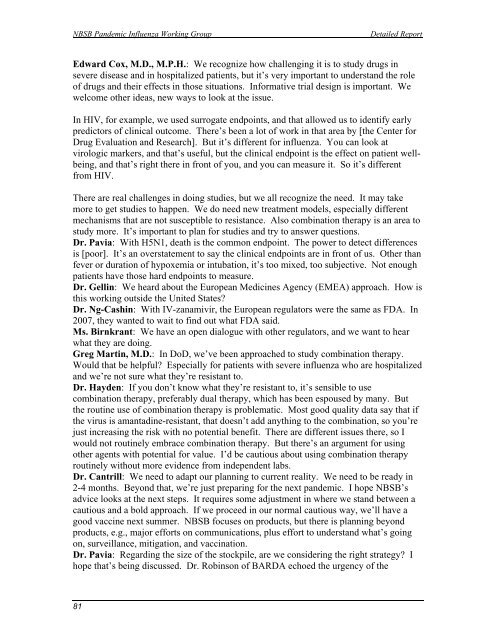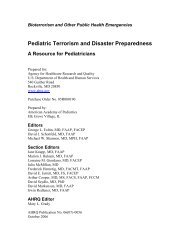H1N1 COUNTERMEASURES STRATEGY AND ... - PHE Home
H1N1 COUNTERMEASURES STRATEGY AND ... - PHE Home
H1N1 COUNTERMEASURES STRATEGY AND ... - PHE Home
You also want an ePaper? Increase the reach of your titles
YUMPU automatically turns print PDFs into web optimized ePapers that Google loves.
NBSB Pandemic Influenza Working Group<br />
Detailed Report<br />
Edward Cox, M.D., M.P.H.: We recognize how challenging it is to study drugs in<br />
severe disease and in hospitalized patients, but it’s very important to understand the role<br />
of drugs and their effects in those situations. Informative trial design is important. We<br />
welcome other ideas, new ways to look at the issue.<br />
In HIV, for example, we used surrogate endpoints, and that allowed us to identify early<br />
predictors of clinical outcome. There’s been a lot of work in that area by [the Center for<br />
Drug Evaluation and Research]. But it’s different for influenza. You can look at<br />
virologic markers, and that’s useful, but the clinical endpoint is the effect on patient wellbeing,<br />
and that’s right there in front of you, and you can measure it. So it’s different<br />
from HIV.<br />
There are real challenges in doing studies, but we all recognize the need. It may take<br />
more to get studies to happen. We do need new treatment models, especially different<br />
mechanisms that are not susceptible to resistance. Also combination therapy is an area to<br />
study more. It’s important to plan for studies and try to answer questions.<br />
Dr. Pavia: With H5N1, death is the common endpoint. The power to detect differences<br />
is [poor]. It’s an overstatement to say the clinical endpoints are in front of us. Other than<br />
fever or duration of hypoxemia or intubation, it’s too mixed, too subjective. Not enough<br />
patients have those hard endpoints to measure.<br />
Dr. Gellin: We heard about the European Medicines Agency (EMEA) approach. How is<br />
this working outside the United States?<br />
Dr. Ng-Cashin: With IV-zanamivir, the European regulators were the same as FDA. In<br />
2007, they wanted to wait to find out what FDA said.<br />
Ms. Birnkrant: We have an open dialogue with other regulators, and we want to hear<br />
what they are doing.<br />
Greg Martin, M.D.: In DoD, we’ve been approached to study combination therapy.<br />
Would that be helpful? Especially for patients with severe influenza who are hospitalized<br />
and we’re not sure what they’re resistant to.<br />
Dr. Hayden: If you don’t know what they’re resistant to, it’s sensible to use<br />
combination therapy, preferably dual therapy, which has been espoused by many. But<br />
the routine use of combination therapy is problematic. Most good quality data say that if<br />
the virus is amantadine-resistant, that doesn’t add anything to the combination, so you’re<br />
just increasing the risk with no potential benefit. There are different issues there, so I<br />
would not routinely embrace combination therapy. But there’s an argument for using<br />
other agents with potential for value. I’d be cautious about using combination therapy<br />
routinely without more evidence from independent labs.<br />
Dr. Cantrill: We need to adapt our planning to current reality. We need to be ready in<br />
2-4 months. Beyond that, we’re just preparing for the next pandemic. I hope NBSB’s<br />
advice looks at the next steps. It requires some adjustment in where we stand between a<br />
cautious and a bold approach. If we proceed in our normal cautious way, we’ll have a<br />
good vaccine next summer. NBSB focuses on products, but there is planning beyond<br />
products, e.g., major efforts on communications, plus effort to understand what’s going<br />
on, surveillance, mitigation, and vaccination.<br />
Dr. Pavia: Regarding the size of the stockpile, are we considering the right strategy? I<br />
hope that’s being discussed. Dr. Robinson of BARDA echoed the urgency of the<br />
81
















